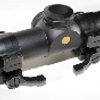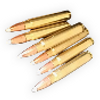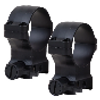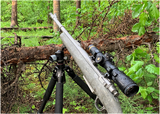This is the joint effort of Morris Melani, owner and operator of Alaska Arms LLC and Dennis Daigger an amateur custom gunmaker.
First the concept.
Dennis:
A workmate living in Southeast Alaska hunted ptarmigan
with me near Cantwell in April several years ago and he was preoccupied
with his favorite hunting that would begin soon. He is a diehard spring
sooty grouse (formerly called blue grouse) hunter and he was looking for
a flatter shooting rifle than his current .22 LR for these hunts.
Hunting the sooties is done during the mating season when the males are ‘hooting’ and can be aurally located. The rest is inordinately precise shooting for heads that are no more than 3/4″ across. His .22 LR limitations were evident for shots out around 60 yards where the bullet’s arching trajectory is significant. Small errors in range estimations would result in misses. He asked if I had any experience with the .17 HMR. I had purchased a used CZ 452 some months earlier and although the rifle was superbly accurate I like better design and finer workmanship than can be had with such a rifle and had been looking for a replacement. The conversations with Frank set me to thinking about a high quality custom .17 HMR again.
I found a Model 6 takedown BSA Martini action locally for the project and got a profiled 26″ Lothar Walther barrel. A Pacific Tool and Gauge chamber reamer and headspace gauges had recently arrived. I was ready to proceed with the project when I met Morris Melani from Big Lake Alaska. Morris is the owner of Alaska Arms LLC that produces top notch quick detach scope ring sets for CZ and Ruger rifles. In the course of conversations with him I mentioned this project and he steered the discussion to ovate barrels. The concept of the rifle expanded and by the time it gelled it was a three-barreled set with .17 HMR, .22LR and 5.6x50R Mag chamberings.
Morris is an outspoken advocate for cut rifled barrels and suggested I contact Dan Pedersen of Classic Barrel and Gun Works for the two .22 caliber barrels and the order was filled in less than two months. Now the major parts were in hand to start the project. These barrels are 27″ long and 1 3/8″ diameter full round blanks and when they arrived the person at the Post Office asked, “WHAT IS IN THIS!!?”.
I occasionally look through the wood inventories of a group of dealers that I have isolated over the years and my search for a blank for this project ended at Old Tree Gun Blanks. Gordon had a nice California thin shell walnut blank that was too small for about anything but this type of gun which can use a short blank. It was a lot of wood for the money but the proof of the pudding is in the eating and it is a long way from being in the action with the right dimensions. The blank has some sap wood at the butt that will take some careful maneuvering to avoid. Gordon sent three well figured and matching forends without extra charge with the blank.
I wanted to put a vintage scope of some type on this rifle and after watching eBay for several months to gauge the market for makers, models and prices available, a 6X Unertl Small Game Scope showed up that was in the condition I wanted. This scope was at the top end of what I wanted to pay. It will, however, compliment the rifle nicely without having to have any reconditioning work done to it.
The Model 6 Martini is a rimfire action and I would need a solution for a centerfire chambering. Numrich Gun Parts lists a number of parts for the Cadet size actions and I ordered a breach block and striker. Unfortunately, Numrich sells an intermediate sized breach block as a Cadet block and after long and heated discussions I gave up on them and placed wanted ads on web forums. Curt Hardcastle sold me a bare rimfire block which would have to be converted to centerfire.
I have been told of a conversion technique where a second detent was created on the bottom of a Cadet breach block to accommodate the ears of the finger lever. The detent that the ears of the lever mate with line up the striker with the proper position for its fall on the rim of the case. A second detent would allow the finger lever to be repositioned. One detent positioned the striker fall for rimfire and the other for the centerfire fall. This simply wasn’t an appealing idea. So a second breach block will be part of this Martini’s ‘kit’ requiring a breach block change when the barrels are changed between rimfire and centerfire.
I have an extraordinary #12 Martini rifle that Hoffman Arms built and it is chambered for the .25-20 WCF. It is a classic rifle and the only small-actioned Martini I have ever seen that was visually appealing from stem to stern. After restudying the rifle I decided the centerfire chambering for this project would be the .25-20 WCF. I ordered another barrel from Classic Barrel and Gun Works in .257 caliber.
I now had two full round barrels and a .17 light sporter profiled blank. In discussions with Morris we concluded that a full round .17 would be more appropriate for the project. Very few .17 caliber barrels are being made but Lothar Walther sells a full round (1.250″) blank and that was ordered.
And the barrel design.
Morris:
Some time ago I was reading through a copy of a Jeffery 1910-1911 catalog and came across a ovate barrel offered
on a Jeffery small bore. This rifle was a 1906 model single shot and
was an eye catcher. Having done a number of integral rib barrels I am
always on the lookout for sleek looking barrels with integral ribs. The
low rib design that flows smoothly into the tangent point of the barrel
sides is one of the most intriguing profiles I have seen. Being both
sleek and elegant, it is perfectly suited for a light barrel with lines
that will not dominate a stock.
The most significant part of being able to establish a small-owned gun part manufacturing business with world-wide marketing in a small community in Alaska is machinery that allows efficient and effective production. I have a HAAS VF2 vertical CNC mill and write production computer programs that allow me to create CAD solids and CAM programs using Mastercam 3D surfacing. These are precisely the capabilities that make it possible to design and machine ovate barrels accurately and economically with all mathematical calculations and tool paths done within Mastercam.
The most appealing element of ovate barrels is the low profile of the rib with a top flat very near the barrel diameter. A low sleek rib perfectly suites this style of barrel for a Hoffman style Martini. How low the rib can be made remains to be seen. I have designed a low profile front sight base that sits on the rib with lines that neatly allows for slightly more front sight height without overwhelming the lines of the barrel. This may not be needed if the rib taper ends up high enough to accommodate the front sight. The deciding factor on the front sight base will be determined by the scope mounting blocks required by the Unertl scope and the rib dimensions needed to accommodate them.
With a muzzle diameter of .525″ and a breech diameter of 1.000″ over the chamber the Hoffman’s most intriguing feature of the barrel is the transition from .750″ to 1.000″ in front of the chamber reinforcement area. This transition takes place over .750″ with a perfect arc. This 22″ Hoffman profile transferred to 26″ barrels will add to the sleek appearance. Preserving these barrel lines while adding a ovate profile will be a challenge well worth undertaking.














